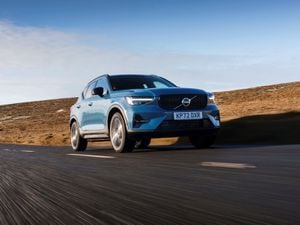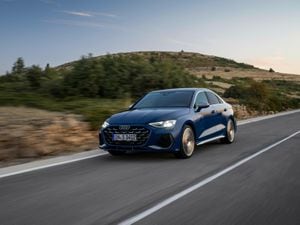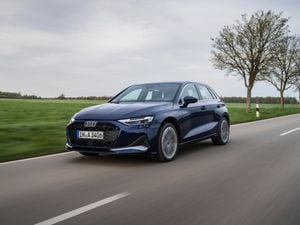UK Drive: The Volvo XC40 continues to be a compelling compact SUV
Now that Volvo has discontinued all its estate cars in the UK, Jack Evans finds out if the popular XC40 SUV is worth considering.

What is it?

If you’ve seen a Volvo on the road lately, we’re pretty sure it’ll have been an XC40. The Swedish firm’s compact SUV really hit the nail on the head from the moment it was revealed back in 2017, entering into a segment which has only gone from strength to strength in recent years.
Volvo has recently gone SUV-only in the UK, so the XC40 stands as one of the brand’s ‘core’ models. But as its most compact model, can the XC40 deliver the kind of roominess and practicality that we’ve come to expect from Volvo? We’ve been finding out.
What’s new?

You might say that Volvo has taken the ‘if it ain’t broke, don’t fix it’ approach with the XC40. Of course, newer, cleaner engines have been introduced to this model since its reveal in 2017, but the styling hasn’t changed all that much. Its interior hasn’t been tweaked all that much either but, again, it made such an impression when it was first showcased that it didn’t really need much changing.
We have seen a greater level of technology in the latest XC40 models, however, while Google’s Automotive services – with in-house features such as Google Maps and Assistant voice control – have now been integrated into the car’s infotainment system seamlessly.
What’s under the bonnet?

You can get the XC40 with a number of efficient electrified powertrains – including a series of plug-in hybrid and also as an EV – but the one we’re driving today is the B3, which uses a mild-hybrid setup combining a 2.0-litre four-cylinder petrol with a very compact electric motor. Driven through an automatic gearbox, it sends power to the front wheels alone in this XC40.
Performance is respectable, with zero to 60mph being conducted in 8.4 seconds. As with all of the latest Volvo models, the top speed is capped at 112mph, too. Efficiency-wise, Volvo claims up to 42.7mpg, while CO2 emissions of between 151 and 166g/km – depending on wheel size – actually feel quite high for what is a relatively compact engine.
What’s it like to drive?

The XC40 is an approachable kind of car, particularly if you’re new to the world of SUVs. Though it has that upright driving position that you want from this type of model, it doesn’t feel overly large or wide – so people who need a confidence-inspiring model will no doubt find it appealing.
It’s comfortable and easy to drive, too. We did notice that the XC40 can be upset by higher-speed lumps and bumps in the road, but once you’re at a steady cruise it’s pleasantly quiet overall. The four-cylinder petrol engine can be a touch vocal when you need a lot of acceleration, but for the most part, it settles into the background well. The steering is light in its standard setting, too, though you can add some extra weight to it via an in-screen menu should you want to.
How does it look?

You can instantly tell that the XC40 is a Volvo. There are those eye-catching ‘Thor’s Hammer’ headlights which have become a hallmark of the Swedish brand, while the prominent grille design with integrated Volvo badge is hard to miss.
The whole car has some quiet boxy, upright proportions which give it a bit more presence than the car’s relatively compact size might make you think. Our test car came in a one-colour design, too, though we’re quite fond of XC40 models with a contrast black roof.
What’s it like inside?

The XC40’s interior uses a design which has become central to modern Volvos. It combines good materials with an intuitive, ergonomic design which feels natural from the moment you step in. Our test car came with cloth seats, too, which were comfortable and supportive while some flashes of silver helped to brighten up what was, overall, quite a dark interior.
Rear-seat space isn’t too bad, though taller passengers might find that legroom could be better. At 578 litres, the boot area is of a good size and it’s not blocked by a load lip either, so loading heavier items inside is a breeze. You can also push it up to an impressive 1,328 litres by folding down the rear seats, too.
What’s the spec like?

Prices for the XC40 start from £35,895 for an entry-level ‘Core’ model. Though it does kick off the range, you still get alloy wheels, LED headlights and the main central display which uses all of those Google-based services. The system itself is really easy to use, too, while the smartphone mirroring it provides works very well.
Our test car came in ‘Plus’ specification. Priced from £40,040, this version adds in a 360-degree camera and more intricate alloy wheels. However, you do get the vast majority of features that come on the Plus also feature on the Core, so you might be better off just opting for the entry version.
Verdict
Though many enthusiasts may have mourned the loss of Volvo estate cars in the UK, you can’t argue with how well executed this firm’s range of SUVs – XC40 included – is. Though previous estate models like the V60 were slightly better to drive as a result of their lower centre of gravity, the XC40’s ease of use, chunky design and practical interior all mean it’s still a great choice.
This four-cylinder petrol version might not have the electric-only running capability of the more expensive plug-in hybrids, but as a day-to-day engine which won’t cost the earth to run, it feels like a great fit for the XC40.





